Genetic Screening and Testing
advertisement
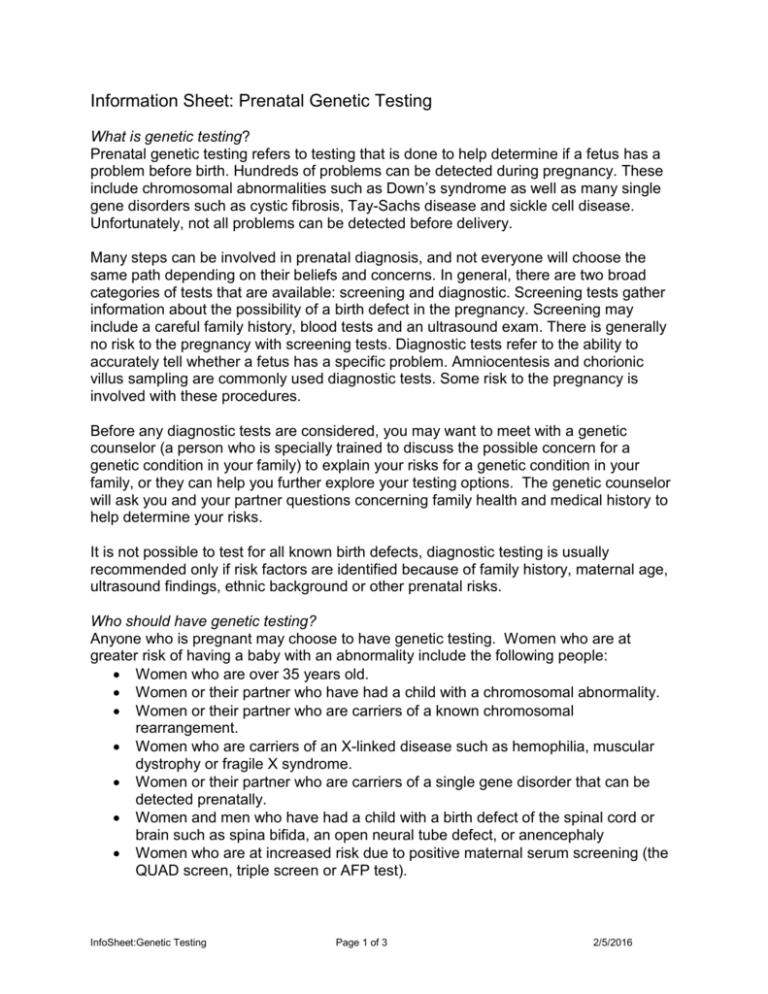
Information Sheet: Prenatal Genetic Testing What is genetic testing? Prenatal genetic testing refers to testing that is done to help determine if a fetus has a problem before birth. Hundreds of problems can be detected during pregnancy. These include chromosomal abnormalities such as Down’s syndrome as well as many single gene disorders such as cystic fibrosis, Tay-Sachs disease and sickle cell disease. Unfortunately, not all problems can be detected before delivery. Many steps can be involved in prenatal diagnosis, and not everyone will choose the same path depending on their beliefs and concerns. In general, there are two broad categories of tests that are available: screening and diagnostic. Screening tests gather information about the possibility of a birth defect in the pregnancy. Screening may include a careful family history, blood tests and an ultrasound exam. There is generally no risk to the pregnancy with screening tests. Diagnostic tests refer to the ability to accurately tell whether a fetus has a specific problem. Amniocentesis and chorionic villus sampling are commonly used diagnostic tests. Some risk to the pregnancy is involved with these procedures. Before any diagnostic tests are considered, you may want to meet with a genetic counselor (a person who is specially trained to discuss the possible concern for a genetic condition in your family) to explain your risks for a genetic condition in your family, or they can help you further explore your testing options. The genetic counselor will ask you and your partner questions concerning family health and medical history to help determine your risks. It is not possible to test for all known birth defects, diagnostic testing is usually recommended only if risk factors are identified because of family history, maternal age, ultrasound findings, ethnic background or other prenatal risks. Who should have genetic testing? Anyone who is pregnant may choose to have genetic testing. Women who are at greater risk of having a baby with an abnormality include the following people: Women who are over 35 years old. Women or their partner who have had a child with a chromosomal abnormality. Women or their partner who are carriers of a known chromosomal rearrangement. Women who are carriers of an X-linked disease such as hemophilia, muscular dystrophy or fragile X syndrome. Women or their partner who are carriers of a single gene disorder that can be detected prenatally. Women and men who have had a child with a birth defect of the spinal cord or brain such as spina bifida, an open neural tube defect, or anencephaly Women who are at increased risk due to positive maternal serum screening (the QUAD screen, triple screen or AFP test). InfoSheet:Genetic Testing Page 1 of 3 2/5/2016 Women who have been exposed to medications, drugs or other dangerous substances during their current pregnancy. Women who are at increased risk due to ultrasound findings. People of certain ethnic backgrounds (Jewish-Tay Sach; African-sickle cell; Asian-thalasemia). What diagnostic testing is available? Amniocentesis Amniocentesis is a procedure that uses a thin needle to remove a small amount (about two to three tablespoons) of the amniotic fluid surrounding the fetus. During the amniocentesis, the baby and the amniotic fluid are seen by ultrasonography to help guide the needle placement. This test is typically done between weeks 15 and 20. Amniotic fluid contains cells shed by the skin of the baby. The fluid sample is given immediately to the laboratory, where the cells are allowed to grow. Typically the chromosomes inside the cells are analyzed to diagnose problems like Down syndrome, and chemicals in the amniotic fluid are analyzed to diagnose spina bifida. Amniocentesis is away to diagnose chromosomal abnormalities and spina bifida. Amniocentesis may test for additional conditions if indicated by the family history or other risk factors. Risks for this test include discomfort, cramping, infection, miscarriage and bleeding. Chorionic villus sampling Chorionic villus sampling (CVS) is a way to collect cells for testing early in the pregnancy. This test is typically done between the 10th and12th week of pregnancy. Cells are taken from the placenta by either placing a thin plastic catheter (tube) through the opening of the cervix or by inserting a needle through the abdomen. CVS done to evaluate the chromosomes inside these cells to diagnose problems like Down syndrome. Other tests may be offered as indicated. Spina bifida cannot be detected with CVS. Like amniocentesis CVS is a method to diagnose chromosomal problems and also has similar risks. However, the risks are thought to be greater than the risk associated with amniocentesis. What screening tests are available? Ultrasound An ultrasound examination uses sound waves to evaluate the fetus. Most major birth defects are found by ultrasound during the second trimester. Unfortunately, ultrasound cannot find all birth defects or other problems, and a normal ultrasound cannot guarantee a healthy baby. Two primary types of ultrasound are used for genetic screeing. 1. If in early pregnancy (between 11 weeks one day and 13 weeks six days), the nuchal translucency (NT) is measured. The NT is the normal fluid- filled space at the back of the baby’s neck. The NT measurement can be used alone to InfoSheet:Genetic Testing Page 2 of 3 2/5/2016 determine if there is a risk for a chromosome abnormality, structural heart defect or other abnormalities in the fetus. It can also be done in combination with a blood test called the Ultra-Screen to provide more information about two specific chromosomal abnormalities, Down syndrome and trisomy 18. 2. A “level II” or “high resolution” ultrasound can be used to see the baby’s overall growth and development. It will also look at the structure of the hear and the brain. This ultrasound is offered between 15 and 22 weeks of gestation. QUAD Screen (maternal serum screen) This is a blood test offered to pregnant women who are between 15 and 20 weeks of pregnancy. This test is often used to replaced the triple screen or AFP test. The QUAD screen measures four proteins in the mother’s blood that are produced by the developing fetus and the placenta. This test is able to screen for the possibility that the fetus could have Down syndrome or trisomy 18, or spina bifida. THe QUAD screen cannot be offered when there is a twin or a triplet pregnancy. Do the results guarantee a normal baby? No, there are no tests available that can guarantee that your baby will be born healthy and well. Screening tests can only help assess your risk for a particular condition. It is important to remember that with screening tests. Both false positive and false negative test results occur. If there is an increased risk for an abnormality, diagnostic testing may provided more accurate information. Prenatal diagnosis is aimed at finding birth defects that are thought to be at increased risk. Many birth defects cannot be found using prenatal diagnosis. These can include blindness, deafness, some heart defects and many types of mental retardation. But the chance that any of these problems would occur is probably low, and most babies are born healthy. Therefore, normal results from prenatal diagnosis should be reassuring, but they cannot rule out every possible birth defect. InfoSheet:Genetic Testing Page 3 of 3 2/5/2016
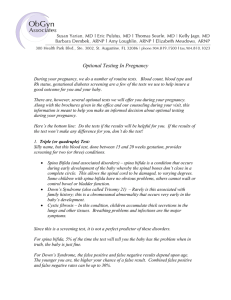
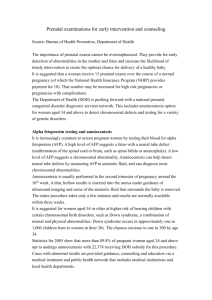

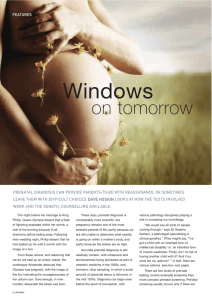
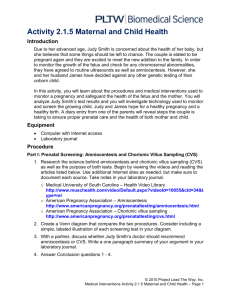


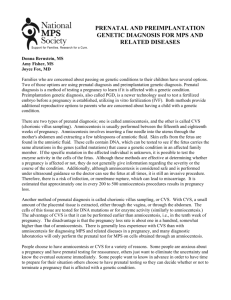
![Jiye Jin-2014[1].3.17](http://s2.studylib.net/store/data/005485437_1-38483f116d2f44a767f9ba4fa894c894-300x300.png)


